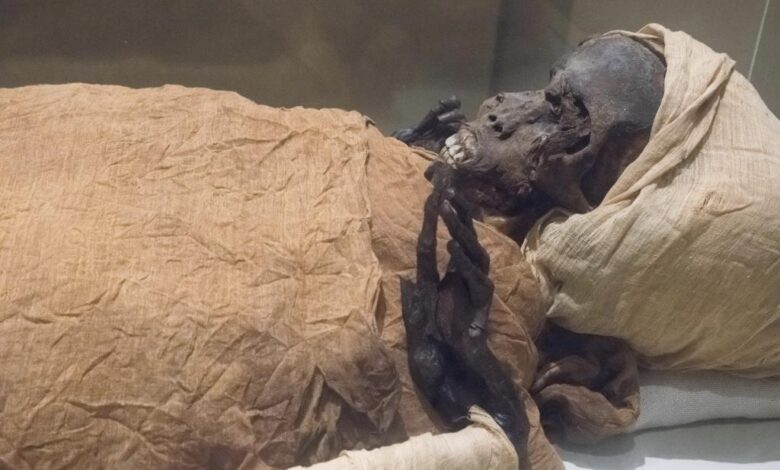CT scans of mummy of ancient Egyptian King Seqenenre-Taa-II revealed the circumstances of his death King

KingSeqenenre-Taa-II was killed while fighting Egypt’s invaders and his embalmers had skillfully concealed some head wounds
Modern medical technology helped tell the story of a king in ancient Egypt who was martyred for the sake of reunifying Egypt in the 16th century BC. In a research published on February 17th in a scientific Journal “Frontiers in Medicine”, Dr. Zahi Hawass, the renowned archaeologist and former Minister of Antiquities, and Dr. Sahar Saleem, professor of radiology at the Faculty of Medicine, Cairo University examined the mummy of King Seqenenre-Taa II by Computed tomography (CT scan).
King Seqenenre Taa II, The Brave, ruled southern Egypt during the occupation of the country by the Hyksos, a foreign ruling dynasty that seized the delta in northern Egypt for about a century (1650-1550 BC). The mummy of Seqenenre was discovered in Deir al-Bahri Royal Cache in 1881 and was examined then for the first time; in 1960s, the mummy was studied by X-ray. These examinations indicated that the deceased King had suffered several severe head injuries; however, there were no injuries to the rest of the body. Theories have differed as to the cause of the death of the King, as some believed that the king was killed in a battle, perhaps by the hands of the Hyksos king himself. Others indicated that Seqenenre may have been killed by a conspiracy while sleeping in his palace. Due to the poor condition of the mummy, some suggested that the mummification may have taken place in a hurry away from the royal mummification workshop,.
CT scan technology is one of the medical imaging techniques used to study archaeological remains, including mummies, safely and non-invasively, which helps to preserve them. CT scans helped study many Egyptian royal mummies and determine age at death, sex, as well as how they died. In their research, the two Egyptian researchers Zahi Hawass and Sahar Saleem presented a new interpretation of the events before and after the death of King Seqenenre, based on two- and three-dimensional CT image reconstruction using advanced computer technologies. The deformed hands indicate that Seqenenre may have been captured on the battlefield, and his hands were tied behind his back, preventing him from deflecting the fierce attack from his face. CT scan of Seqenenre mummy revealed details of the head injuries, including wounds that had not been discovered in previous examinations and had been skillfully hidden by embalmers.
The research included a study of various Hyksos weapons stored at the Egyptian Museum in Cairo, including an axe, a spear, and several daggers. Saleem and Hawass confirmed the compatibility of these weapons with the wounds of Seqenenre. The results indicate that Seqenenre was killed by multiple hits from different angles by several Hyksos attackers who used different weapons. Seqenenre was rather killed in a ceremonial execution. This indicates that Seqenenre was really on the front line, risking his life with his soldiers to liberate Egypt.
This CT study also determined that Seqenenre was about forty years old at the time of his death, based on the shape of the bones (such as the pubic symphysis joint) providing the most accurate estimate to date.
Zahi Hawass, the former Egyptian Minister of Antiquities, and Sahar Saleem, a professor of radiology, are pioneers in the use of CT scans to study several royal mummies of the New Kingdom including reputable warriors such as Thutmose III, Ramses II and Ramses III; however, Seqenenre appears to be the only one among them who was on the front line of the battlefield.
In addition, thisstudy revealed important details about the embalming of the body of Seqenenre. For example, embalmers used a sophisticated method of hiding wounds on the king’s head under a layer of embalming material that works similarly to the fillings used in modern plastic surgery. This means that the mummification was actually done in a royal mummification workshop rather than a poorly prepared place, as was previously suggested.
This study provides important new details about a pivotal point in Egypt’s long history. The death of Seqenenre stimulated his successors to continue the struggle to unify Egypt and to found the New Kingdom. In a stela known as the Tablet of Carnavaron, found in the Temple of Thebes of Karnak, the battles fought by Kamos, son of Seqenenre, are recorded against the Hyksos. Kamos fell dead during the war against the Hyksos, and it was Ahmose, the second son of Seqenenre, who completed the expulsion of the Hyksos. He fought them, defeated them, and chased them until (modern Gaza in Palestine) and reunited Egypt.








